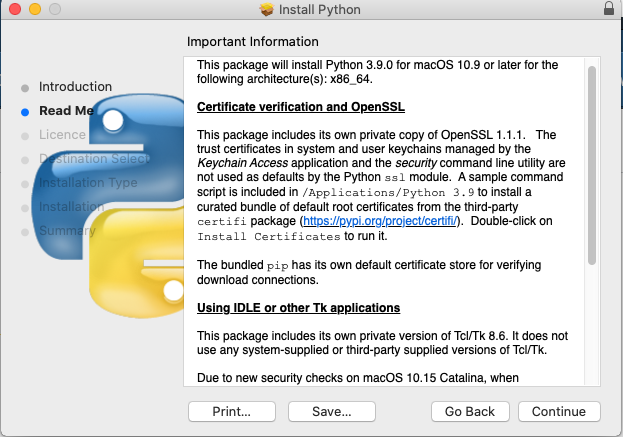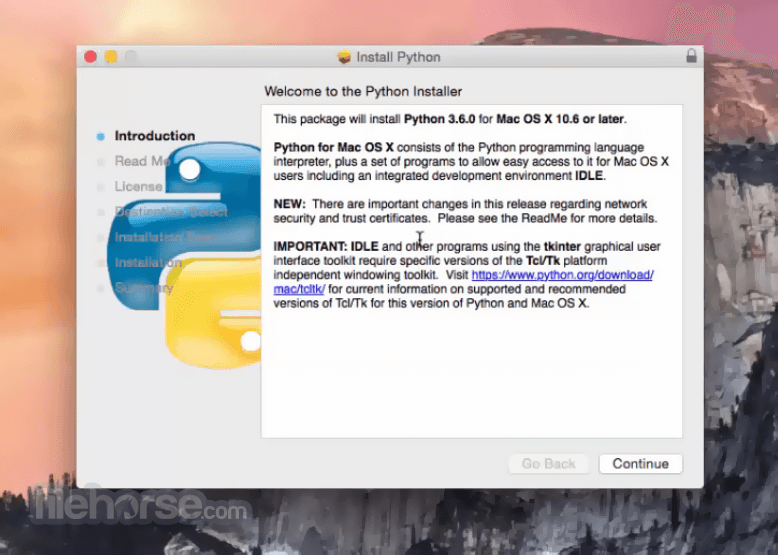

Opening python on mac how to#
Understanding the contrast between them is critical before you learn how to work with Python files. Python classifies files into one of two categories: text or binary. However, Python deals with files differently than Windows, or any other OS does.
Opening python on mac windows#
Essentially, a file in Windows is any item that you can create, manipulate, and delete. In the OS, you can manipulate these files and organize them in folders that form sophisticated directories. At the technical level, files are simply named locations on a disk drive with related data stored in them.ĭisk drives are used to store data permanently since RAM is volatile and loses data when the computer is shut down. When you use an operating system like Windows, "files" mean images, documents, videos, audio clips, executables, and the like. You must remember that while fundamentally related to each other, files and file objects are separate things. Similarly, the "name" attribute of the file object reveals the name of the file opened.

It describes the mode in which the file opened. Furthermore, these details also come in handy when you want to manipulate the file you open.įor instance, "mode" is one of the few attributes that every file object has associated with it. The function returns a "file object."įile objects comprise methods and attributes which can be used to gather information about the file you open. Opening a file in Python is as simple as using the open() function that is available in every Python version. Python comes with functions that enable creating, opening, closing, reading, and writing files built-in. We will also cover using the "with" statement in this post. In this Python tutorial, you'll learn about opening, reading, writing, and closing files. Python is one of the most popular programming languages, and unlike some other languages, it does not require you to import a library to work with files.įiles are handled natively in Python however, the methods of working with files are different from other languages. Make a program that displays the lyrics of a song.Īfter completing these continue with the next exercise.Last Updated: Wednesday 29 th December 2021.Make a Python program that prints your name.If you are a beginner, then I highly recommend this book. You should see a line of text showing “hello world”. Other IDEs have a similar process to run a Python program (start project, add file, run button). Another option is to click right mouse button on your Python file and selecting run. Click the green triangle to start the program.Add new Python file (File new) and add hello.py.On the main menu, choose File | New Project.Welcome screen opens, click Create New Project.py files (or create them in the IDE) and press run. To run a Python script from an IDE, start a project first. To change directory use the command ‘cd’ like this ‘cd /home/user/pythonprojects’ or ‘cd C:\Projects\’. If you use Windows the directory is shown in the command line title bra.
Opening python on mac mac os#
On Mac OS and Linux you can see the current directory with the command pwd. That means, the directory where your python program is located. To start the program, we have to open the command line and type:įor this to work you need to be in the correct directory. You can hit command+space and type terminal, then hit enter. On Mac OS use finder to start a terminal. To open a terminal on Windows: press the windows key + r key (run program), type cmd or command and press enter. This works on all platforms (Mac OS, Windows, Linux). You can start a Python program with the terminal or command line. Related course: Complete Python Programming Course & Exercises Run Python Run from terminal I recommend using a text editor that supports syntax highlighting (text colouring) and line numbers. You can use any text editor to create a Python program. The text below can be copied into a text editor and save as hello.py. The 3rd line outputs a line of text “hello wlrd” to the screen. The first line indicates that we want to use the Python interpreter. Whenever you make a Python script, save it as name.pyĪ simple program (hello.py) is shown below. Execute Python scripts in the terminal or an IDE.


 0 kommentar(er)
0 kommentar(er)
